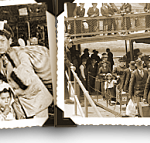General Tips
A Well-Kept Secret: The Internet Archives is an Amazing Resource for Genealogists
October 4, 2011 by ramona
Filed under Articles, General Tips, Getting Started in Genealogy, Introduction to Genealogy
 The Internet Archives is front-page news for all beginning genealogists and family historians. Internet Archives is taking a lesson from the lost library of Alexandria. Alleged to be the greatest repository of knowledge in the known world, the Great Library housed books written by the most renowned scholars and philosophers: but all that was lost when it burned to the ground. In collaboration with the Smithsonian and the Library of Congress, The Internet Archives is actively working to digitize and preserve written records for coming generations. This is great news for genealogists.
The Internet Archives is front-page news for all beginning genealogists and family historians. Internet Archives is taking a lesson from the lost library of Alexandria. Alleged to be the greatest repository of knowledge in the known world, the Great Library housed books written by the most renowned scholars and philosophers: but all that was lost when it burned to the ground. In collaboration with the Smithsonian and the Library of Congress, The Internet Archives is actively working to digitize and preserve written records for coming generations. This is great news for genealogists.
The archives has an ever expanding compilation of resources consisting of items from the National Library of Scotland, The University of Toronto and the Boston Public Library to name a few.
What you will find at the Internet Archives
Some major genealogical resources you can find on their site include Biographical documents, Vital Statistics and books on surname origins. Perhaps most significant to genealogy research is their collection of Old Parish Registers from Great Britain, Canada and the United States. Even better is the fact that accessing this information is easy and free.
How to access records
For beginning genealogists or those new to online research it may seem a little complicated at first. Do not be intimidated, it is actually effortless to get straight to the information you want in three simple steps.
Because Genealogy Beginner is here to help you, we have put together a little walk through to get you started, just click to Old Parish Registers and scroll to the Record of the parish list of deaths. 1785-1819 – Bentley, William, 1759-1819, Salem Mass.
Step one:
Click on Record of the parish list of deaths. 1785-1819 – Bentley, William, 1759-1819, Salem Mass. and it will take you to http://www.archive.org/details/recordofparishli00bent
Step two:
Click on “editable web page” at the bottom of the first text box and it will take you to “Open Library”
Step three:
Click “read online” at the top of the right hand column. Once you are here, you are ready to read. At the bottom of the page, you can use the page-turner icons or simply drag your mouse to select a specific page. The richness of genealogical information is astounding. For instance, on page 143 of this document you can find entry # 1087 that gives the following account:
“Nov.7. Margaret, widow of Benjamin Nurse. Fever, etc., 67 years. She was a Welcome in Daniels Street. Married at 26, and lived thirty years in married life. Her husband a baker. Left two children: eldest son in Boston. Her Brother Thomas married a Lambert. A sister Foye only one left. Daniels Street.”
Wrap up
In addition to the main collection, there are also sub collections that cover passenger lists, Military records and books from the Brigham Young University Family History Library. The Internet Archive is a wholly not-for-profit organization. It was founded for the sole purpose of building an internet library that offers unending access to historical collections for researchers, historians, genealogists and the public. The Internet Archives is a site that all genealogists need to bookmark.
Learn How To Research Your Family Tree
September 5, 2011 by Chris
Filed under General Tips, No Header
 The team at Genealogy Beginner is proud to provide the first, step-by-step digital genealogy training that is also fully supported by professional genealogists. We’ve taken over 8 years experience delivering genealogy training services and guides and combined them into the most comprehensive, yet fun, and easy to follow genealogy training available online:
The team at Genealogy Beginner is proud to provide the first, step-by-step digital genealogy training that is also fully supported by professional genealogists. We’ve taken over 8 years experience delivering genealogy training services and guides and combined them into the most comprehensive, yet fun, and easy to follow genealogy training available online:
Unit 1: Introduction to Genealogy
- Lesson 1-1: Genealogy Standards and Guidelines. (What you need to Know First)
- Lesson 1-2 : Recording your Family Tree; First Steps ( Family Group Sheets)
- Lesson 1-3 : Organizing For a successful search (Developing an organization System)
- Lesson 1-4 : Your Tree; Staring your first Search (All About Pedigree Charts)
- Lesson 1-5 : What’s in a Name: Surname Searches ( All about Surname Searches)
- Lesson 1-6: What’s in a First Name? ( How to use in searches as Hints and clues)
- Lesson 1-7: Where did they go? Where is that? ( Searching By Place)
- Lesson 1-8: A Look at Genealogy Software ( The good, The Bad and the Ugly)
Unit 2: Introduction to Research Resources
- Lesson 2-1 : Begin at Home : Local Research
- Lesson 2-2 : Expanding Your Search; States/Provinces
- Lesson 2-3 : Going the Distance; National Records
- Lesson 2-4 : Worldwide; Your growing Tree (done copy to here)
- Lesson 2-5 : Making Connections; Reaching out (Correspondence and Repository Logs)
- Lesson 2-6 : Information Sharing (news Groups/Message Boards & Social Networking in Genealogy)
- Lesson 2-7 : Hereditary and Lineage organizations ( It may already be done)
- Lesson 2-8 : GEDCOM 101
Unit 3: Records 101
- Lesson 3-1: Vital Records and Old Parish Registers; Digging Deeper
- Lesson 3-2a: Finding Facts in Government Death Records
- Lesson 3-2b: Death records and funerary customs in the Old Parochial Records and Kirk Sessions.
- Lesson 3-3: Additional Death Record information sources, (Monumental Inscriptions and Obituaries wills, probate records & deeds)
- Lesson 3-4: In The Field; Using (Cemetery tracking forms)
- Lesson 3-5: I DO – A look at Marriage Records
- Lesson 3-6: Bans and Proclamations
- Lesson 3-7: Finding and using Birth Records
- Lesson 3-8 Baptisms and Christenings
Unit 4: Record types – searching, requesting and using information types
- Lesson 4-1 : Going to Church; Following Their Faith ( Searches by Denomination)
- Lesson 4-2 : The LDS; The Largest Resource (What it & What You can Find)
- Lesson 4-3 : LDS Continued (How to Search it)
- Lesson 4-4 : How Did They Get Here (Immigration, Emigration and Naturalization)
- Lesson 4-5 : Ellis Island
- Lesson 4-6: Across the Waves (Ships lists, Passenger lists, Ports of Entry and Departure)
- Lesson 4-7: Staking their Claim ( Land Records, Homesteading Records, Land Grants, Deeds and Petitions)
- Lesson 4-8: Tax Records ( What they contain and why they are important)
Unit 5 Record Types Continued
- Lesson 5-1 : Using the Census ( Introduction and instruction)
- Lesson 5-2 : Tracking a Military Past (military Records)
- Lesson 5-3 : Where they worked (Using occupational records)
- Lesson 5-4 : Where to look when you just can’t find them (Poor house-work house-alms house-asylum-prison)
- Lesson 5-5 :Special searches (Adoption and Fostering)
- Lesson 5-6: Visiting the Courthouse (Court Records)
- Lesson 5-7: Get out and Vote (Voter Registration)
- Lesson 5-8: Getting Educated ( Alumni and School records)
Unit 6 Putting It all Together
- Lesson 6-1 : Preserving Your Family Tree ( Scrapbooks and Websites)
- Lesson 6-2 : Biographies and Diaries
- Lesson 6-3 : Old Photographes
- Lesson 6-4 : Family Hierlooms
- Lesson 6-5 : Newspaper Articles and clippings
- Lesson 6-8: Family Réunions
Blank Family Tree Download
July 14, 2011 by Sherri
Filed under General Tips
Download Your Blank Family Tree Template
Frequently Asked Questions
- How do I read a *.pdf file?The Family Tree Template is saved as an Adobe PDF file. Most computers come with a free version of Adobe PDF pre-installed. We use this file format because it is the most universally used format for files across the web. If you are not able to read the file, please visit Adobe directly and download the latest version of their free reader software.
- What do you mean by “right-click”?If you bring your mouse over the link above (the one titled, “Download the Family Tree Template” and click the right mouse button, you be presented with a drop-down menu that gives you a number of options. Select “save as” and you will be prompted to save the file.
- I’ve downloaded the file but don’t understand how to fill out the Family Tree Template.We’re not able to provide you instructions on how to fill out the Family Tree Chart by email (you can image the volume of email we get). However, we have made the chapter, “How to Complete a Family Tree Chart” from the Step-by-Step Genealogy Guide available. You can read about this chapter by clicking on the link below:
What next?
Become a member, and get access to our community forums, genealogy lessons and more!
Or sign up for a free trial and sample the benefits of membership.
Check your email inbox for any message from us and simply hit reply to tell us how we might help.
Accessing Military Records
March 8, 2009 by Chris
Filed under Articles, Genealogy Military Records, Genealogy Records 101, General Tips
 The following came from a current subscriber to Genealogy Beginner.
The following came from a current subscriber to Genealogy Beginner.
“Great advice: First I would like to let you know I enjoy your tips. As a beginner they have been very helpful. I know different states have laws in reference to military records. In the state of South Carolina military records are not public. The information can only be given to the individual, their Power of Attorney, or spouse. The SC state statute is very clear and states that the military records can only be used for genealogical research 50 years after the death of the person whose military records are referenced. I know this to be a fact because I work in the office where the military records are recorded in Aiken County, South Carolina.”
We have to be very cautious as to who has access to these documents.
Where to Next? Blank Family Tree Template
Download the Genealogy Guide
November 13, 2008 by Chris
Filed under General Tips
 What is a Step-by-Step Genealogy Guide worth? To have someone do all the research for you would normally cost you around $800 (I should know, that’s what it cost me!). Particularly laser-guided accurate information like I provide in The Guide – SPECIFICALLY for managing name challenges from other countries. This isn’t some boiler-plate collection of answers. Everything is explained in PLAIN English. Which means it’s dead-easy to read and understand. And it’s logically laid out. There are other resources out there retailing for over $27.
What is a Step-by-Step Genealogy Guide worth? To have someone do all the research for you would normally cost you around $800 (I should know, that’s what it cost me!). Particularly laser-guided accurate information like I provide in The Guide – SPECIFICALLY for managing name challenges from other countries. This isn’t some boiler-plate collection of answers. Everything is explained in PLAIN English. Which means it’s dead-easy to read and understand. And it’s logically laid out. There are other resources out there retailing for over $27.
Which is why “Step-by-Step Genealogy Guide” is such a bargain the price we have it at today.
That’s right, a fraction of what it’s really worth and what it cost me to research. Why would I make it so affordable? Simply because my costs to deliver it to you are so low. This is an electronic book (e-book) that can be downloaded to your computer in a flash. Which means you can be reading it and discovering all these amazing secrets in as little as 5 minutes from now. Ain’t that a hoot!
So I figure I’ll be able to offer this fantastic resource of information (which if you follow the tips contained in its pages could save you thousands of dollars easily in the next few months) to more people. And make any investment back over time. No matter what however, it’s a bargain for you. And yes, I plan on raising the price very soon. Once I get a few more testimonials from satisfied customers, the price will increase. So you’ll want to be quick if you want to save some bucks.
Pick up your copy today!


